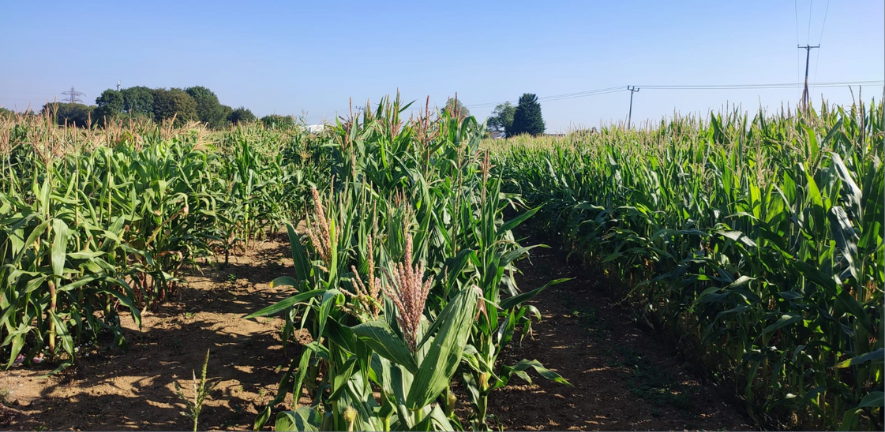
Submitted by Jane Durkin on Tue, 29/04/2025 - 15:43
Researchers from the University of Cambridge in collaboration with colleagues from the Scuola Superiore Sant'Anna in Pisa and the University of Essex, have identified new genetic factors that can influence the efficiency of photosynthesis in maize.
The research offers a valuable new approach to improving productivity in crops like maize – one of the world’s most important cereal crops. In the case of maize, even minimal increases in productivity can have significant impacts on global food security.
Photosynthesis is the process by which plants use solar energy to produce nutrients for their growth. Increasing the efficiency of this mechanism means making the plants we cultivate more productive and consequently increasing their yield.
The study used approaches from genetics, genomics, and molecular biology to demonstrate that there is genetic diversity in the maize we cultivate, and that this can lead to substantial changes in how the crop can use energy from the sun.
Specifically, the research identified genetic variants present in some types of maize from temperate regions that significantly limit their photosynthetic capacity.
The findings could be particularly useful for improving production in cooler climates like the UK and northern Europe where the amount of land given to growing maize has expanded considerably in recent decades and is likely to continue to rise.
The study was published in ‘The Plant Cell’ on 24 April 2025.
The research is part of a major European project called CAPITALISE looking at natural genetic variation in photosynthesis in maize, barley and tomato for higher yielding crops.
An area ripe for exploration
The idea behind the study is to understand and optimise the processes that regulate the 'switching on and off' of certain components of the photosynthetic machinery.
Dr Johannes Kromdijk, head of the Environmental Plant Physiology group at the University of Cambridge and senior author of the paper explains “Until now there was a view that photosynthesis didn’t vary that much within species. This project is challenging that idea. We’re now finding natural variation in photosynthetic traits in tomato, barley and in this case maize.”
“Other yield factors have already been explored and are unlikely to give such big improvements. So photosynthetic efficiency is an area ripe for exploration,” Dr Kromdijk says.
The results significantly contribute to defining objectives for the genetic improvement of maize, opening new perspectives in terms of the impact and sustainability for cultivation.
Fine-tuning photosynthesis for better crop productivity
Co-first author of the study, Dr John Ferguson is Assistant Professor at the University of Essex and previously postdoctoral researcher at the Environmental Plant Physiology group in Cambridge.
“It is critical that we begin to understand the genetics regulating photosynthesis in crops. This will enable us to fine tune photosynthesis and improve crop productivity,” he says.
“In this study, we used a combination of genomics and high-throughput trait measurements to discover genes that regulate the response of photosynthesis to dynamic light. This is important because in a field setting crops are exposed to variable light.”
“We discovered that the activity of one gene in particular (CP24) is central to regulating the response of photosynthesis to changing light. This has important implications for maize breeding and offers opportunities for designing strategies to optimize photosynthetic efficiency in maize.”
Findings particularly relevant for growing maize in cooler climates
The project involved a team of researchers working over two years to measure a collection of around 300 specific genotypes of maize in a field trial at Niab just outside Cambridge.
It was a huge endeavor. “You’re talking 640 plots,” Dr Kromdijk says.
“It’s not the most common environment where maize gets tested usually. We’re quite far north,” he adds.
“This may be a finding that’s particularly relevant for temperate climates,” Dr Kromdijk explains. “The founder line that’s poorly expressing CP24 is a line that was traditionally used to make crops more suitable for a shorter growing season, which is what you need in cooler climates.”
The next steps are to see how this works in a hybrid context. Maize grown in the field is typically a hybrid. So, testing to see if the findings translate is a crucial next step.
Reference: Ferguson, JN et al., A deficient CP24 allele defines variation for dynamic nonphotochemical quenching and photosystem II efficiency in maize, The Plant Cell, Volume 37, Issue 4, April 2025, https://doi.org/10.1093/plcell/koaf063
Image: Maize field trials at Niab as part of the CAPITALISE research. Photo credit: John Ferguson.
